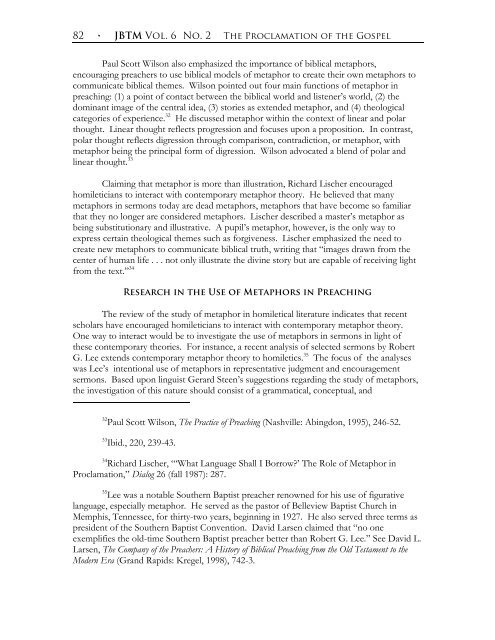0 jbtm vol. 6, no. 2 the proclamation of the gospel - Baptist Center for ...
0 jbtm vol. 6, no. 2 the proclamation of the gospel - Baptist Center for ...
0 jbtm vol. 6, no. 2 the proclamation of the gospel - Baptist Center for ...
You also want an ePaper? Increase the reach of your titles
YUMPU automatically turns print PDFs into web optimized ePapers that Google loves.
82 ٠ JBTM Vol. 6 No. 2 The Proclamation <strong>of</strong> <strong>the</strong> Gospel<br />
Paul Scott Wilson also emphasized <strong>the</strong> importance <strong>of</strong> biblical metaphors,<br />
encouraging preachers to use biblical models <strong>of</strong> metaphor to create <strong>the</strong>ir own metaphors to<br />
communicate biblical <strong>the</strong>mes. Wilson pointed out four main functions <strong>of</strong> metaphor in<br />
preaching: (1) a point <strong>of</strong> contact between <strong>the</strong> biblical world and listener’s world, (2) <strong>the</strong><br />
dominant image <strong>of</strong> <strong>the</strong> central idea, (3) stories as extended metaphor, and (4) <strong>the</strong>ological<br />
categories <strong>of</strong> experience. 32 He discussed metaphor within <strong>the</strong> context <strong>of</strong> linear and polar<br />
thought. Linear thought reflects progression and focuses upon a proposition. In contrast,<br />
polar thought reflects digression through comparison, contradiction, or metaphor, with<br />
metaphor being <strong>the</strong> principal <strong>for</strong>m <strong>of</strong> digression. Wilson advocated a blend <strong>of</strong> polar and<br />
linear thought. 33<br />
Claiming that metaphor is more than illustration, Richard Lischer encouraged<br />
homileticians to interact with contemporary metaphor <strong>the</strong>ory. He believed that many<br />
metaphors in sermons today are dead metaphors, metaphors that have become so familiar<br />
that <strong>the</strong>y <strong>no</strong> longer are considered metaphors. Lischer described a master’s metaphor as<br />
being substitutionary and illustrative. A pupil’s metaphor, however, is <strong>the</strong> only way to<br />
express certain <strong>the</strong>ological <strong>the</strong>mes such as <strong>for</strong>giveness. Lischer emphasized <strong>the</strong> need to<br />
create new metaphors to communicate biblical truth, writing that “images drawn from <strong>the</strong><br />
center <strong>of</strong> human life . . . <strong>no</strong>t only illustrate <strong>the</strong> divine story but are capable <strong>of</strong> receiving light<br />
from <strong>the</strong> text.” 34<br />
Research in <strong>the</strong> Use <strong>of</strong> Metaphors in Preaching<br />
The review <strong>of</strong> <strong>the</strong> study <strong>of</strong> metaphor in homiletical literature indicates that recent<br />
scholars have encouraged homileticians to interact with contemporary metaphor <strong>the</strong>ory.<br />
One way to interact would be to investigate <strong>the</strong> use <strong>of</strong> metaphors in sermons in light <strong>of</strong><br />
<strong>the</strong>se contemporary <strong>the</strong>ories. For instance, a recent analysis <strong>of</strong> selected sermons by Robert<br />
G. Lee extends contemporary metaphor <strong>the</strong>ory to homiletics. 35 The focus <strong>of</strong> <strong>the</strong> analyses<br />
was Lee’s intentional use <strong>of</strong> metaphors in representative judgment and encouragement<br />
sermons. Based upon linguist Gerard Steen’s suggestions regarding <strong>the</strong> study <strong>of</strong> metaphors,<br />
<strong>the</strong> investigation <strong>of</strong> this nature should consist <strong>of</strong> a grammatical, conceptual, and<br />
32 Paul Scott Wilson, The Practice <strong>of</strong> Preaching (Nashville: Abingdon, 1995), 246-52.<br />
33 Ibid., 220, 239-43.<br />
34 Richard Lischer, “‘What Language Shall I Borrow?’ The Role <strong>of</strong> Metaphor in<br />
Proclamation,” Dialog 26 (fall 1987): 287.<br />
35 Lee was a <strong>no</strong>table Sou<strong>the</strong>rn <strong>Baptist</strong> preacher re<strong>no</strong>wned <strong>for</strong> his use <strong>of</strong> figurative<br />
language, especially metaphor. He served as <strong>the</strong> pastor <strong>of</strong> Belleview <strong>Baptist</strong> Church in<br />
Memphis, Tennessee, <strong>for</strong> thirty-two years, beginning in 1927. He also served three terms as<br />
president <strong>of</strong> <strong>the</strong> Sou<strong>the</strong>rn <strong>Baptist</strong> Convention. David Larsen claimed that “<strong>no</strong> one<br />
exemplifies <strong>the</strong> old-time Sou<strong>the</strong>rn <strong>Baptist</strong> preacher better than Robert G. Lee.” See David L.<br />
Larsen, The Company <strong>of</strong> <strong>the</strong> Preachers: A History <strong>of</strong> Biblical Preaching from <strong>the</strong> Old Testament to <strong>the</strong><br />
Modern Era (Grand Rapids: Kregel, 1998), 742-3.


